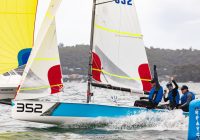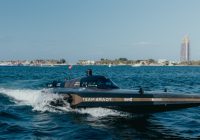Towing safely
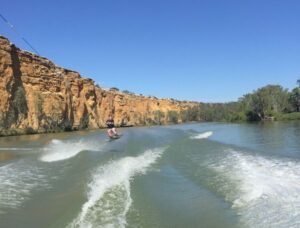
The popularity of towing skiers on the River Murray can lead to overcrowding. Towing involves a vessel pulling a person and watersport equipment with a rope (or line) and includes waterskiing, knee-boarding or aquaplaning, parasailing, wakeboarding and riding on an inflatable inner tube, raft or biscuit. When you combine high speeds required for towing with a crowded river it can get dangerous.
Please remember:
- Anyone being towed must wear a level 50 or 50S lifejacket.
- If you fall in the water, you must (unless injured) hold an arm or ski vertically in the air to signal your presence.
- When towing, the skipper, observer and the person being towed must all stay under the 0.05 alcohol limit.
- Skippers must not tow more than three people at once, this includes 3 skiers or 3 people on one device.
- A boat must not travel within 100 metres of, or directly behind, a person who is being towed by another boat.
- Always check the waterway for hazards before you begin your towing session.
- Always ensure the skipper is a licensed driver and you have an observer who is at least 16 years of age watching. The observer must continuously watch the skier and give the operator of the boat any directions necessary to ensure the safety of the skier.
- A person between 12 and 15 years of age can also act as an observer if they hold a Special Permit and the skipper is at least 18 years of age.
- At high speeds, it is even more important to maintain a proper lookout, not just for the boat, but for the person you are towing.
- Before you go, ensure your boat and towing equipment is safe and suitable.
- When leaving, approaching or in front of a take-off area you must only turn in an anti-clockwise direction (keep to the right / starboard side of the waterway).
- Boats leaving a take-off area must keep out of the way of boats arriving. Boats entering the take-off area have the right of way.
Be ferry aware
Remember to follow these rules:
- Within 100 metres of a ferry crossing, you must reduce your speed to 4-knots either side of the crossing.
- All vessels must give way to a ferry which is crossing the channel and avoid crossing ahead of the ferry.
- Never pass close to a ferry that is crossing the river. The heavy steel cables used to guide the ferry may be close to the surface and can seriously damage a boat.
- Always slow down and if necessary, stop and wait for the ferry to reach the bank before crossing.
- If your vessel is fitted with a horn, a four-to six-second blast should be sounded when between 800m and 400m from the ferry, then proceed with caution.
- If your vessel is not fitted with a horn, then approach the ferry with caution.
- A ferry signals its intention by showing a flashing green light when at rest on either side of the river.
- At Mannum where there are two ferries, proceed when either one or both are showing their green flashing lights.
Watch this short video which reminds you about staying safe near ferry crossings.
Boat ramps can be slippery
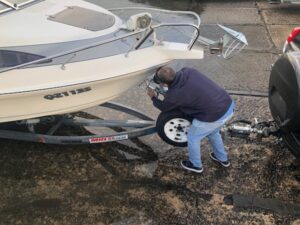
To help keep you safe remember these safety tips:
- Walk down the boat ramp first to check how slippery it is and how much drop off there is.
- If you are inexperienced in launching at a boat ramp, take some time to watch more experienced boaters launching their boats.
- Don’t end up with your car in the water – remember to put your handbrake on.
- If the boat ramp has a drop off at low tide, try and time retrieving your boat when the tide has risen.
- Remember there is a 4-knot speed limit within 30 metres of a jetty, wharf or other place where a vessel is being removed or placed into the water (includes boat ramps). Please keep to this speed limit in these busy areas.
Check out our Boat Ramps in South Australia publication for more information.
Did you know?
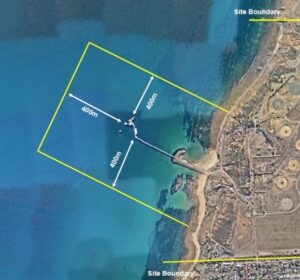
Port Stanvac exclusion zone
A Restricted Area is still in place in Port Stanvac Harbour even though the jetty has been removed. No vessels or people can enter the Restricted Area. There are several other exclusion zones in place under the South Australian Harbours and Navigation Regulations 2009.
The restricted areas are in place to stop people and vessels entering specific areas. They are often port, harbour and wharf areas.
Aquatic events such as regattas and swimming events can also apply for an aquatic activity licence for an exclusive use of a waterway for a period of time.
Visit schedule five of Harbors and Navigation Regulations 2009 for a full list of restricted areas. Restrictions listed include:
- area exclusion zones
- area speed limits
- types of vessels that can be used in an area
- types of aquatic activities that can or cannot occur in an area.
Currency Creek speed limit reminder
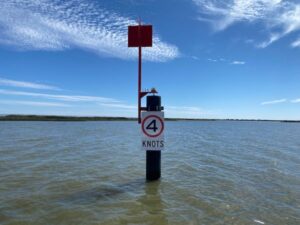
The Department for Infrastructure and Transport’s Marine Services area is always looking to improve on water signage to help users navigate safely.
New 4-knot speed limit markers have recently been installed at Currency Creek. The markers remind users to keep to the 4-knot speed limit on this waterway.
A person must not operate a vessel fitted with an engine in Currency Creek at a speed in excess of 4 knots.
Let someone know before you go
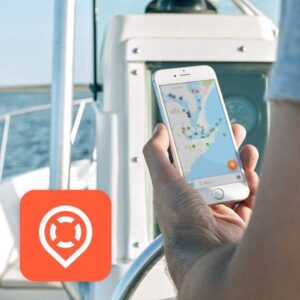
Always let a relative or friend know when, where and for how long you plan to head out for on your vessel. If you don’t return, they can help by providing emergency services with key information about your location.
For those with marine radios on board let Volunteer Marine Rescue (VMR) know you are heading out and when you plan to return. For more information contact your local VMR group directly.
Free boating apps like Deckee are another option to help keep you safe on the water.
The Deckee app has a safety feature called ‘float plan’. You can fill in trip details and share the plan with a friend or family member. They can monitor how long you’ve been gone and will receive a notification when you’re overdue, so they can make contact or alert the authorities. You can download the Deckee app here. It also includes local information, weather and nav.





